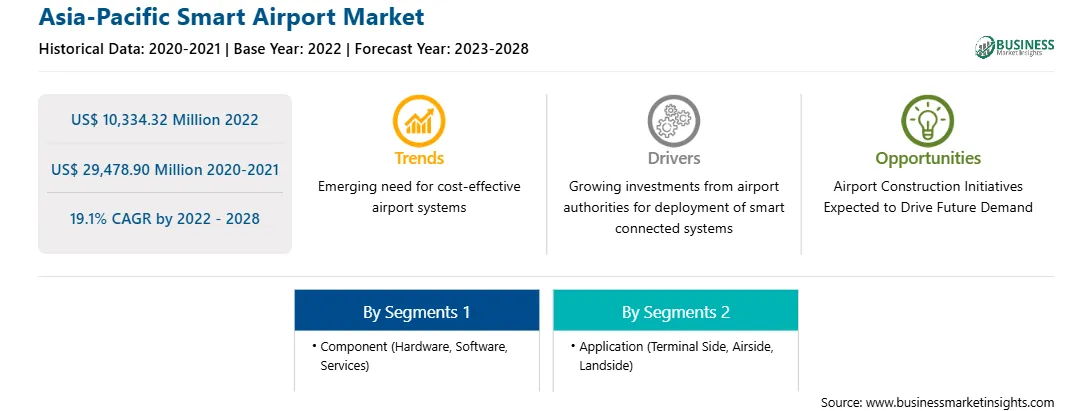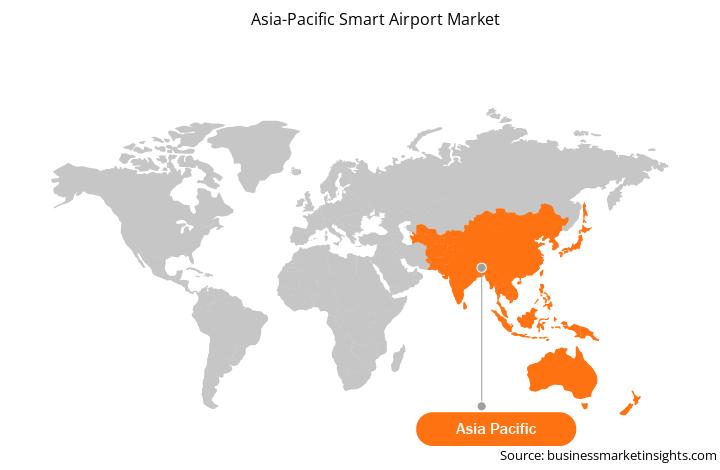The APAC smart airport market is expected to grow from US$ 10,334.32 million in 2022 to US$ 29,478.90 million by 2028; it is estimated to grow at a CAGR of 19.1% from 2022 to 2028.
Companies in the smart airport industry are focusing on providing customer-centric solutions to boost the adoption of smart airport technologies. Passengers' demand for baggage tracking is on the rise across the region, which is one of the focus areas for airport authorities. According to the Civil Aviation Administration of China (CAAC), in 2021, ~75% of the air passengers in China wanted to know their baggage tracking details and collection time. As per the same research, ~86% of airlines in China focus on providing baggage tracking notifications, and 57% of the airlines also provide baggage collection information to their passengers across China. Vendors in the smart airport market focus on providing smart airline baggage management systems to airlines to automate their business operations and provide a better experience to passengers. Such systems are integrated with cloud-based airline applications and databases, cloud-based analytics, and a machine-to-machine (M2M) and IoT platform to connect, manage, and secure real-time data and events from smart luggage. Moreover, the deployment of baggage management systems in airports also helps reduce the overall operational costs, along with boosting overall operational efficiencies. Therefore, the focus of vendors on customer-centric offerings is expected to drive the market growth across the region in the coming years.
With the new features and technologies, vendors can attract new customers and expand their footprints in emerging markets. This factor is likely to drive the APAC smart airport market. The APAC smart airport market is expected to grow at a good CAGR during the forecast period.
Strategic insights for the Asia-Pacific Smart Airport provides data-driven analysis of the industry landscape, including current trends, key players, and regional nuances. These insights offer actionable recommendations, enabling readers to differentiate themselves from competitors by identifying untapped segments or developing unique value propositions. Leveraging data analytics, these insights help industry players anticipate the market shifts, whether investors, manufacturers, or other stakeholders. A future-oriented perspective is essential, helping stakeholders anticipate market shifts and position themselves for long-term success in this dynamic region. Ultimately, effective strategic insights empower readers to make informed decisions that drive profitability and achieve their business objectives within the market.

| Report Attribute | Details |
|---|---|
| Market size in 2022 | US$ 10,334.32 Million |
| Market Size by 2028 | US$ 29,478.90 Million |
| Global CAGR (2022 - 2028) | 19.1% |
| Historical Data | 2020-2021 |
| Forecast period | 2023-2028 |
| Segments Covered |
By Component
|
| Regions and Countries Covered | Asia-Pacific
|
| Market leaders and key company profiles |
The geographic scope of the Asia-Pacific Smart Airport refers to the specific areas in which a business operates and competes. Understanding local distinctions, such as diverse consumer preferences (e.g., demand for specific plug types or battery backup durations), varying economic conditions, and regulatory environments, is crucial for tailoring strategies to specific markets. Businesses can expand their reach by identifying underserved areas or adapting their offerings to meet local demands. A clear market focus allows for more effective resource allocation, targeted marketing campaigns, and better positioning against local competitors, ultimately driving growth in those targeted areas.

APAC Smart Airport Market Segmentation
The APAC smart airport market is segmented based on component, application, and country. Based on component, the APAC smart airport market is bifurcated into hardware and software. The hardware segment dominated the market in 2022. The hardware segment is further categorized into security system, communication and navigation system, endpoint devices, and data storage. Based on application, the APAC smart airport market is segmented into terminal side, airside, and landside. The terminal side segment dominated the market in 2022. Based on country, the APAC smart airport market is segmented into China, India, Japan, South Korea, Australia, and rest of APAC. China dominated the market in 2022.
Amadeus IT Group SA; Cisco Systems, Inc.; Collins Aerospace; Daifuku Co., Ltd.; Honeywell International Inc.; Huawei Technologies Co., Ltd.; Indra Sistemas, S.A.; SITA; Thales Group; and T-Systems International GmbH. are among the leading companies in the APAC smart airport market.
The Asia-Pacific Smart Airport Market is valued at US$ 10,334.32 Million in 2022, it is projected to reach US$ 29,478.90 Million by 2028.
As per our report Asia-Pacific Smart Airport Market, the market size is valued at US$ 10,334.32 Million in 2022, projecting it to reach US$ 29,478.90 Million by 2028. This translates to a CAGR of approximately 19.1% during the forecast period.
The Asia-Pacific Smart Airport Market report typically cover these key segments-
The historic period, base year, and forecast period can vary slightly depending on the specific market research report. However, for the Asia-Pacific Smart Airport Market report:
The Asia-Pacific Smart Airport Market is populated by several key players, each contributing to its growth and innovation. Some of the major players include:
The Asia-Pacific Smart Airport Market report is valuable for diverse stakeholders, including:
Essentially, anyone involved in or considering involvement in the Asia-Pacific Smart Airport Market value chain can benefit from the information contained in a comprehensive market report.